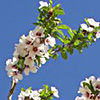Amygdalus ramonensis is a small deciduous shrub that grows wild in Israel in the Negev Highlands region. It usually grows on limestone rocks and shallow soil in an association with Pistacia atlantica (Atlantic Pistacia) at an altitude of 700-900 meters. However, when it develops in a niche where the soil is deep, in the same habitat, it may develop into a tree.
The leaves of Amygdalus ramonensis are small and pointed at their tip, and alternate on the stem. The lateral branches are thin and end in a pointed and prickly tip. Bloom occurs during February and March. Aggregates of flowers are arranged along the stem, and most of them open at the same time. The flower has five pink-white petals. The center is dark and emphasizes the light hue of most of the petal. The calyx is short and has five sepals that are fused at their base. There are numerous stamens and the ovary is inferior.
After pollination, a fruit that is a drupe develops. The fruit is ovate, obtuse at its head. It is 25 mm long and has a diameter of 17 mm. When the fruit ripens, the outer shell is shed and the seed remains covered with a hard protective shell.
The seeds of Amygdalus ramonensis are bitter and inedible. The toxicity of almonds is imparted by a material, amygdalin, that contains the toxin cyanide and after which the almond is named. As long as the seed is intact, the amygdalin is preserved in the cells and the poison is inactive. However, if someone tries to eat the seed and crushes the cells, the amygdalin comes into contact with an enzyme that degrades it and releases the cyanide. This mechanism of protection against being eaten is not unique solely to the almond, and exists in other plants as well, where the most famous is the Cassava (Manihot esculenta), also called Tapioca, whose thick roots are used for preparing porridge and drinks.
Prof. Avinoam Danin defined Amygdalus ramonensis as a new species, endemic to the Negev Highlands, in 1980. However, other researchers claim that this species is endemic. Its distribution is Irano-Turanian. The plant is rare and is protected by law.
Written by Dr. Erga Aloni






